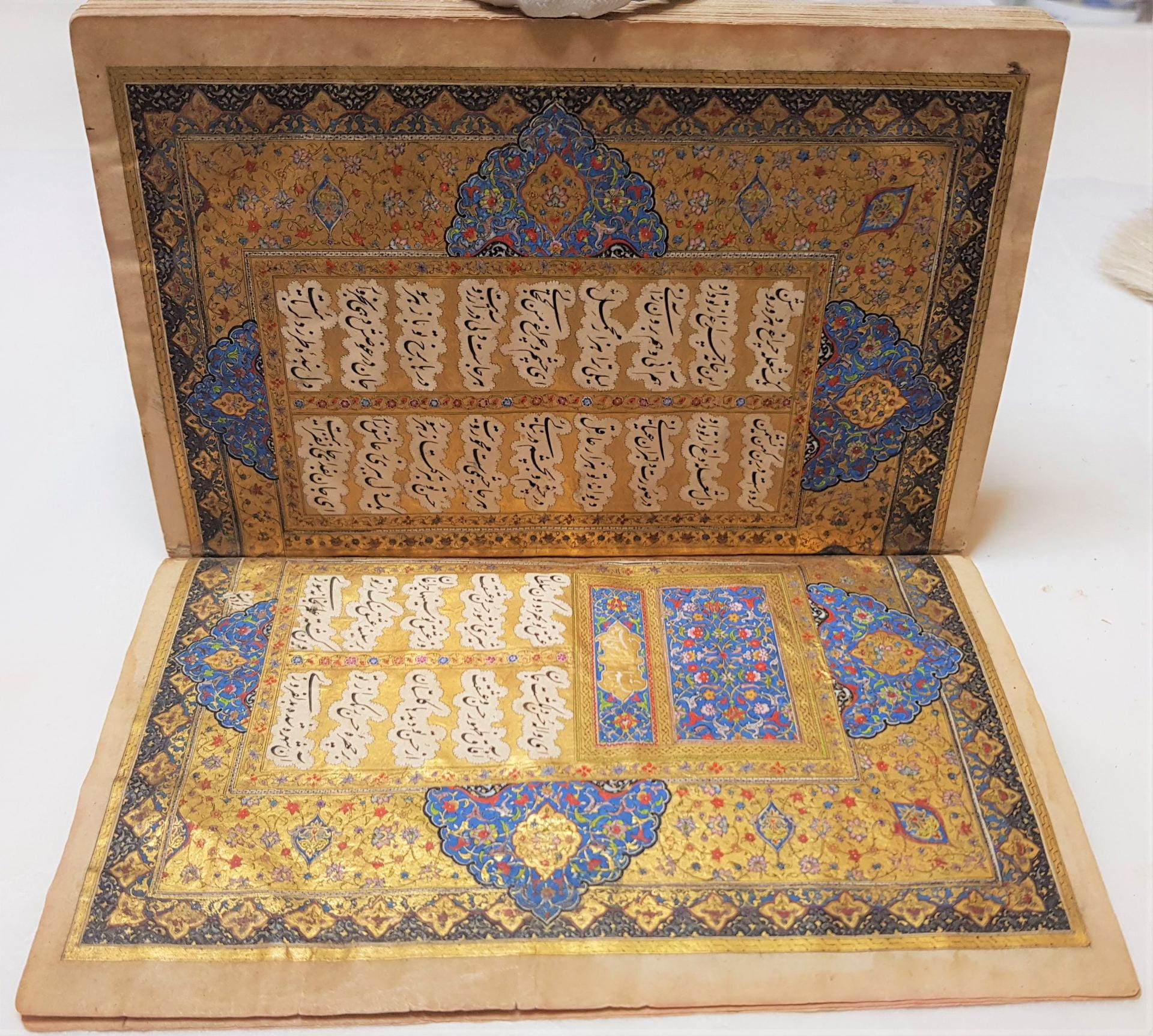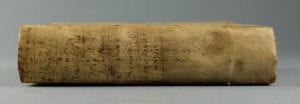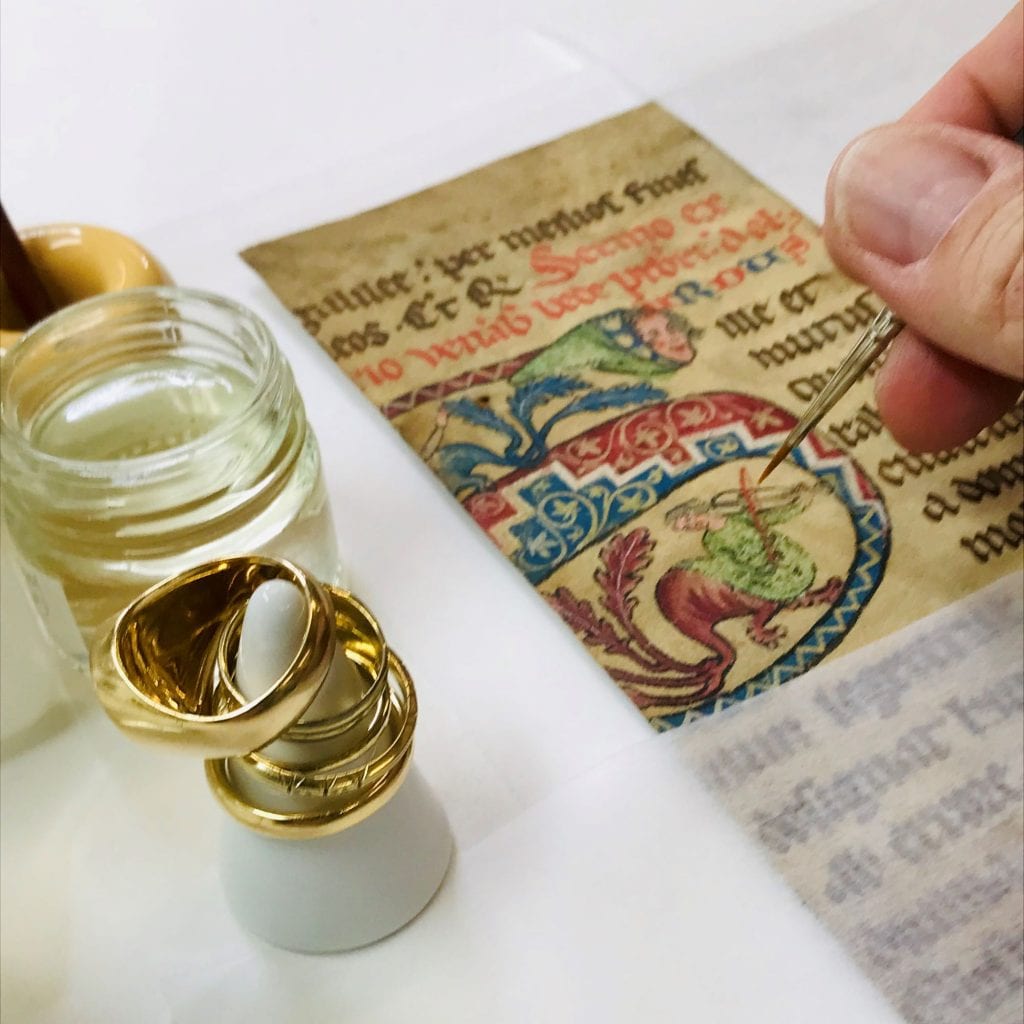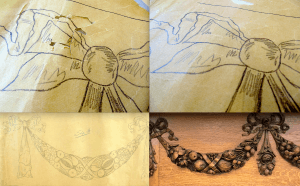Conserving the UCL Islamic Treasures: Masnavi-I Akbar Sultan: MS Pers/1
By Angela Warren-Thomas, on 29 May 2020
UCL’s Special Collections contains UCL’s collection of historical, academic and culturally significant works. It is one of the foremost university collections of manuscripts, archives and rare books in the UK. Included in its holdings is a collection of Islamıc manuscripts, Masnavi-i Akbar Sultan (“Romance of the Sultan Akbar”), (MS PERS/1), is one of the manuscripts in this collection.
The conservation of this manuscript was carried out by Fatma Aslanoglu, Project conservator
The Masnavi-i Akbar Sultan by Mír shams al-Dín Faqír Dihlavi originally written by Jalal al-Din Muhammad Rumi (1207-1273), is a copy of part of the Mesnevi poem collection. Written in Persian using carbon ink and Ta’liq calligraphy, the manuscript contains a poem written for Sultan Akbar in 1749. Bound in an Islamic style using the Lacquer technique, the book came to the conservation department because the binding was very tight, causing restricted opening and making access and handling for any purpose unsafe.
A preliminary examination of the manuscript determined that it had undergone previous repairs, the binding was now too tight compressing the textblock preventing free opening, causing distress and damage. It was decided to rebind the manuscript thus alleviating these problems, and ensure safe access to this important collection item. It appeared that during previous repairs, the original covers were reused but the leather on the spine had been replaced. Figure 2 shows the extent to which the manuscript opened without undue force. In addition to the problems created by the spine repair, superficial dust, separation of the text block and cover, tears, and stains were noted, along with fragility of the end leaves due to the acidity present in their paper, these conditions contributed to different but significant deteriorations in the manuscript.
The first step was removing the cover from the text block. The leather covering of the spine consisted of two pieces of leather, one attached to the left board and one attached to the right board. This is a typical characteristic of Islamic bindings and made it easier to separate the covers from the text block. The spine leather removal was carried out using Methylcellulose to hydrate the adhesive, allowing easy mechanical removal.
It became obvious as the removal of the binding progressed that the manuscript had not been fully disbound during the old repair. The original leather spine covering was still present under the new leather added during the repair. The sewing appeared untouched but the original primary endband sewing and endbands had been renewed.
The original leather and adhesive – probably ciris, a traditional paste made with the root of a yellow asphodel -were still preventing the manuscript from opening fully. Using Methylcellulose, the spine was hydrated, and the residue removed. The original spine lining, a typical characteristic of Islamic bindings, and adhesive was then removed from the text block. After removing all the original leather adhesives and lining from the spine, the text block started to open fully. This allowed the original sewing of the text block to be preserved.

Figure 5 Spine leather residue (left) textile lining (mid-left) residue cleaning process (mid-right) spine diagram (right)
With spine cleaning complete, the tie-down sewing and endbands added during the repair were removed. The text block had three sewing stations, in some of the gatherings; some threads were detached or broken. New thread was attached to the existing thread and the sewing repaired using the original sewing holes.
During the old repairs, new end papers were attached; the paper used for these is now known to be highly acidic therefore, a decision was taken to remove them from the textblock. Fabriano paper was used to create new end leaf papers.
The original textile spine lining was not strong or wide enough to hold the text block because its width had been trimmed during the old repair. A new textile lining was adhered to the text block with excess left along the front and back joints, for later reattachment of the boards.
Following the repair and stabilisation of the textblock spine, it was now possible to proceed with the dry cleaning of the textblock using a soft hake brush.
Paper repairs were carried out using re-moistenable Japanese tissue paper (Japico 0.02/3.8g – Using 4% (w,v) Methylcellulose). These two processes were completed after the spine-lining repair because the spine and sewing were so sensitive to opening and closing.
Another form of paper repair undertaken was the removal of paper layers adhered to the folios from the adjacent pages. The delaminated pieces were removed mechanically with local humidification and a spatula. They were then reattached to their original places using 4% Methylcellulose.
The new spine lining was trimmed at the head and tail of the textblock. An additional traditional leather core was added to the head and tail of the spine to further stabilise the structure. The primary endbands were sewn through the spine lining. It was decided to not re-use the endband created during the old repair. An endband with a chevron pattern was added.
A barrier between the spine and the text block, using the hollow back method, was created using Japanese tissue and pasted with wheat starch paste (1:6). This technique ensured that the manuscript would be able to open comfortably and therefore prevent any further damage to the gilded decorations present on all the pages.

Figure 10 Hollow back process http://(https://carolingianrealm.blog/JournalView.php?EntryID=256)
After the textblock treatments, the boards were reattached to the text block. The spine lining extensions were positioned within the original board layers using wheat starch paste.
The spine leather was then pasted onto the hollow back present on the spine with wheat starch paste. Japanese tissue appropriately toned using Schmincke acrylics was added to the inner joint, the final process carried out to complete the conservation.
Working on The Masnavi-i Akbar Sultan manuscripts was a rare occasion to work on non-Western binding structures and a first-hand learning experience under the expert guidance of Fatma, for the conservators at the Conservation Department.
For more information about this manuscript please visit the UCL Special Collections page. (https://ucldigitalpress.co.uk/Book/Article/2/9/48/)
NOTE: Due to the COVID-19 outbreak, we are unfortunately unable to provide an image of the final state of conservation. We will update this article with a photograph as soon as possible.
 Close
Close




















